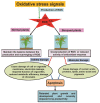Regulation of Reactive Oxygen Species during Salt Stress in Plants and Their Crosstalk with Other Signaling Molecules-Current Perspectives and Future Directions
- PMID: 36840211
- PMCID: PMC9964777
- DOI: 10.3390/plants12040864
Regulation of Reactive Oxygen Species during Salt Stress in Plants and Their Crosstalk with Other Signaling Molecules-Current Perspectives and Future Directions
Abstract
Salt stress is a severe type of environmental stress. It adversely affects agricultural production worldwide. The overproduction of reactive oxygen species (ROS) is the most frequent phenomenon during salt stress. ROS are extremely reactive and, in high amounts, noxious, leading to destructive processes and causing cellular damage. However, at lower concentrations, ROS function as secondary messengers, playing a critical role as signaling molecules, ensuring regulation of growth and adjustment to multifactorial stresses. Plants contain several enzymatic and non-enzymatic antioxidants that can detoxify ROS. The production of ROS and their scavenging are important aspects of the plant's normal response to adverse conditions. Recently, this field has attracted immense attention from plant scientists; however, ROS-induced signaling pathways during salt stress remain largely unknown. In this review, we will discuss the critical role of different antioxidants in salt stress tolerance. We also summarize the recent advances on the detrimental effects of ROS, on the antioxidant machinery scavenging ROS under salt stress, and on the crosstalk between ROS and other various signaling molecules, including nitric oxide, hydrogen sulfide, calcium, and phytohormones. Moreover, the utilization of "-omic" approaches to improve the ROS-regulating antioxidant system during the adaptation process to salt stress is also described.
Keywords: ascorbate peroxidase; catalase; hydrogen sulfide; nitric oxide; omics; phytohormones; reactive oxygen species; salt stress; superoxide dismutase.
Conflict of interest statement
The authors declare no conflict of interest.
Figures






Similar articles
-
Modulation of Ethylene and Ascorbic Acid on Reactive Oxygen Species Scavenging in Plant Salt Response.Front Plant Sci. 2019 Mar 18;10:319. doi: 10.3389/fpls.2019.00319. eCollection 2019. Front Plant Sci. 2019. PMID: 30936887 Free PMC article. Review.
-
Silicon nanoparticles in higher plants: Uptake, action, stress tolerance, and crosstalk with phytohormones, antioxidants, and other signalling molecules.Environ Pollut. 2022 Oct 1;310:119855. doi: 10.1016/j.envpol.2022.119855. Epub 2022 Aug 5. Environ Pollut. 2022. PMID: 35940485 Review.
-
Regulation of Reactive Oxygen Species and Antioxidant Defense in Plants under Salinity.Int J Mol Sci. 2021 Aug 28;22(17):9326. doi: 10.3390/ijms22179326. Int J Mol Sci. 2021. PMID: 34502233 Free PMC article. Review.
-
Reactive oxygen species and antioxidant machinery in abiotic stress tolerance in crop plants.Plant Physiol Biochem. 2010 Dec;48(12):909-30. doi: 10.1016/j.plaphy.2010.08.016. Epub 2010 Sep 15. Plant Physiol Biochem. 2010. PMID: 20870416 Review.
-
Role of Reactive Oxygen Species and Hormones in Plant Responses to Temperature Changes.Int J Mol Sci. 2021 Aug 17;22(16):8843. doi: 10.3390/ijms22168843. Int J Mol Sci. 2021. PMID: 34445546 Free PMC article. Review.
Cited by
-
The Physiological and Molecular Mechanisms of Silicon Action in Salt Stress Amelioration.Plants (Basel). 2024 Feb 15;13(4):525. doi: 10.3390/plants13040525. Plants (Basel). 2024. PMID: 38498577 Free PMC article. Review.
-
Molecular Communication of Microbial Plant Biostimulants in the Rhizosphere Under Abiotic Stress Conditions.Int J Mol Sci. 2024 Nov 19;25(22):12424. doi: 10.3390/ijms252212424. Int J Mol Sci. 2024. PMID: 39596488 Free PMC article. Review.
-
Impact of homologous overexpression of PR10a gene on improving salt stress tolerance in transgenic Solanum tuberosum.J Genet Eng Biotechnol. 2024 Dec;22(4):100437. doi: 10.1016/j.jgeb.2024.100437. Epub 2024 Nov 13. J Genet Eng Biotechnol. 2024. PMID: 39674650 Free PMC article.
-
An A-6 subgroup member of DREB gene family positively regulates cold stress tolerance by modulating an antioxidant defense system in transgenic potato.Sci Rep. 2025 May 2;15(1):15421. doi: 10.1038/s41598-025-98886-0. Sci Rep. 2025. PMID: 40316657 Free PMC article.
-
Selenium foliar application alleviates salinity stress in sweet william (Dianthus barbatus L.) by enhancing growth and reducing oxidative damage.Sci Rep. 2025 Feb 15;15(1):5570. doi: 10.1038/s41598-025-89463-6. Sci Rep. 2025. PMID: 39955337 Free PMC article.
References
-
- Kesawat M.S., Kherawat B.S., Singh A., Dey P., Kabi M., Debnath D., Saha D., Khandual A., Rout S., Ali A. Genome-wide identification and characterization of the brassinazole-resistant (BZR) gene family and its expression in the various developmental stage and stress conditions in wheat (Triticum aestivum L.) Int. J. Mol. Sci. 2021;22:8743. doi: 10.3390/ijms22168743. - DOI - PMC - PubMed
-
- Kesawat M.S., Kherawat B.S., Singh A., Dey P., Routray S., Mohapatra C., Saha D., Ram C., Siddique K.H., Kumar A. Genome-Wide Analysis and Characterization of the Proline-Rich Extensin-like Receptor Kinases (PERKs) Gene Family Reveals Their Role in Different Developmental Stages and Stress Conditions in Wheat (Triticum aestivum L.) Plants. 2022;11:496. doi: 10.3390/plants11040496. - DOI - PMC - PubMed
Publication types
LinkOut - more resources
Full Text Sources

